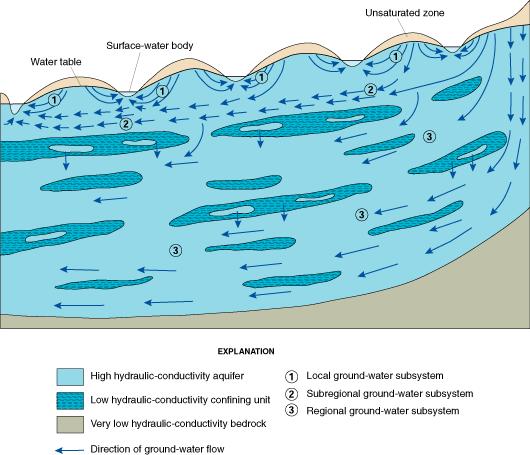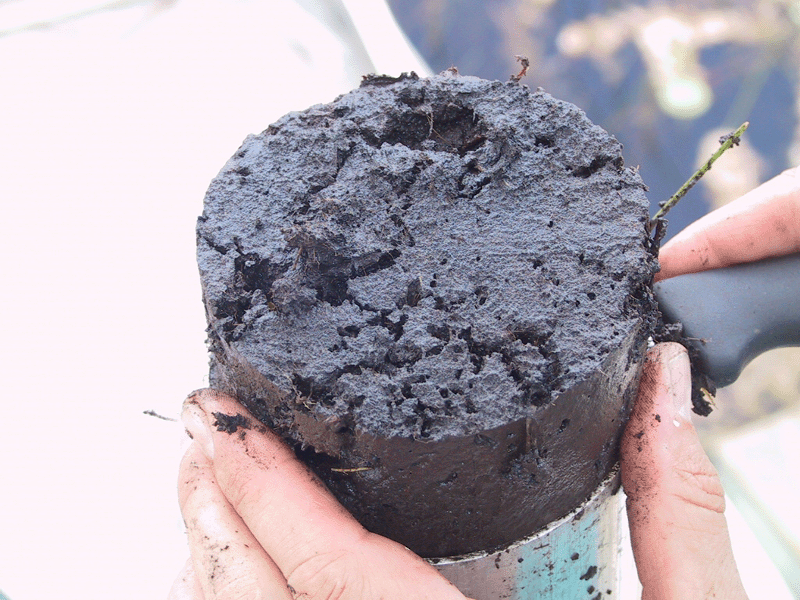|
ENGINEERING HYDROLOGY 022 : HYDROLOGIC ABSTRACTIONS
0.00
Hydrologic abstractions important in Engineering Hydrology are the following:
- Interception
- Infiltration
- Surface or depression storage
- Evaporation
- Evapotranspiration

1. INTERCEPTION
1.01
Interception is the process by which precipitation is abstracted by vegetation or other forms of surface cover.
1.02
Throughfall is that part of precipitation which reaches the ground after passing through the vegetative cover.
1.03
Interception losses are a function of:
- storm character, including intensity, depth and duration;
- type, extent and density of vegetative cover,
- time of the year, that is, season.
1.04
Annual interception losses, primarily from light storms, can amount to 25% of rainfall.

Measurement of interception, University of Liège, Belgium.
1.05
However, for heavy storm events, interception losses usually amount to a small fraction of total rainfall.
1.06
Thus, for flood studies, the neglect of interception is generally justified on practical grounds.
2. INFILTRATION
2.01
Infiltration is the process by which precipitation is abstracted by seeping into the soil below the land surface.

2.02
The infiltrated water moves predominantly in a vertical direction until it reaches the groundwater table.

2.03
Groundwater flows laterally, along a piezometric gradient, toward zones of lower elevation, and eventually goes on to constitute the
baseflow of streams and rivers.

2.04
Infiltration is measured in millimeters per hour, or inches per hour.
2.05
The
rate of infiltration is integrated over the storm duration to obtain the total infiltration, in millimeters or inches.
2.06
The average rate of infiltration is obtained by dividing the total infiltration amount by the storm duration.
2.07
Infiltration rates vary as function of:
- The condition of the land surface, or crust
- The type, extent, and density of vegetative cover
- The physical properties of the soil, including grain size and gradation
- The storm character, that is, intensity, depth, and duration
- The water temperature
- The water quality, including chemical constituents and other impurities
2.08
In general, infiltration varies as a function of the physical, chemical, and biological properties of the soil mass.
2.09
Typically, infiltration rates are greater in humid regions than in arid regions.
2.10
This is
because of the presence of macropores as a result of root structure.

U.S. Geological Survey
2.11
This figure compares
four vegetation types for absorption, runoff and eroded material, in terms of percentage of precipitation.
2.12
Note that the lesser root structure, the lesser the absorption and the greater the eroded material.

2.13
Infiltration rates have a tendency to decrease with time.
2.14
This fact led Horton to develop his decay formula for infiltration:
2.15
2.16
This equation has three parameters: initial rate fo, final rate fc, and decay constant
k.
2.17
With a knowledge of the final rate fc, two sets of measurements can be solved simultaneously
to give the initial rate fo and the decay constant k.

2.18
Typical infiltration rates at the end of 1 hr are shown here.
2.19
| Soil group | f1 (mm/hr)
|
| Low (clays, clay loam)
| 0.25 - 2.5
|
| Intermediate (loams, clay, silt)
| 2.5 - 12.5
|
| High (sandy soils)
| 12.5 - 25.0
|
2.20
Note that these practical values of infiltration rate vary only within two orders of magnitude,
compared to theoretical values, which can vary up to 12 orders of magnitude.
2.21
Practical evaluations of infiltration rate have been hampered by its spatial and temporal variability.
2.23
This has led to the concept of infiltration index.
2.24
An infiltration index assumes that the rate is constant throughout the storm.

Michigan Tecnological University
2.25
According to the Horton formula, the infiltration index underestimates the initial rate and may overestimate the final rate.
2.26
Therefore, it is best suited for long-duration storms.
2.27
In this case, the neglect of the variation with time is justified on practical grounds.
2.28
The φ-index is defined as the constant infiltration rate to be substracted from the prevailing rainfall rate
in order to obtain the runoff depth and volume that actually occurred.
2.29
The φ-index is calculated by trial and error.
2.30

3. SURFACE OR DEPRESSION STORAGE
3.01
Surface or depresion storage is the process by which precipitation is abstracted by being temporarily retained in puddles, ditches,
and other natural or artificial depressions of the land surface.
3.02
The spatial variability of storage in surface depressions precludes its precise calculation.
3.03
Depression storage is inversely related to catchment slope.

Wetland near Corumba, Mato Grosso do Sul, Brazil.
3.04
Depression storage is likely to be small in steep catchments, and large in mild catchments.
3.05
Depression storage effectively reduces peak flows.
3.06
The NRCS's TR-55 model uses a surface storage correction factor to account for depression storage in peak flow calculations.
Narrator: Dr. Victor M. Ponce
Music: Fernando Oñate
Editor: Flor Pérez
Photo Credits: Google
Copyright © 2010
Visualab Productions
All rights reserved
| 









